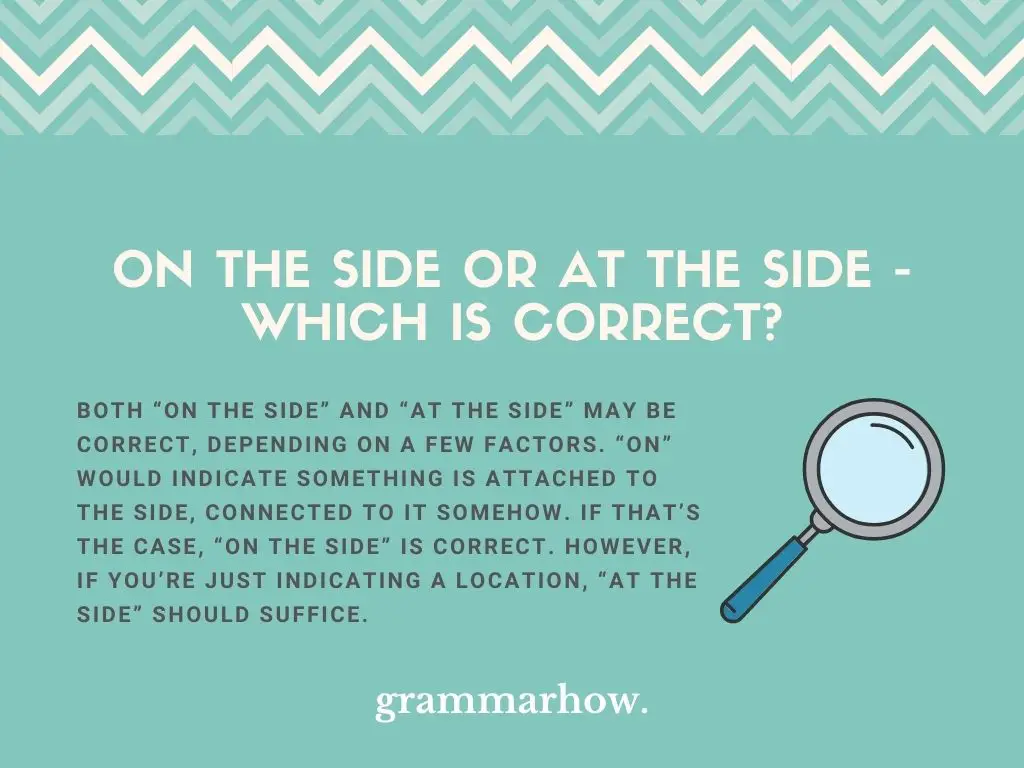There are many ways we can indicate the location of an object (or person, for that matter). However, what is the most accurate way to do it?
When talking about the sides of an item, for example, should we say “On the Side” or “At the Side”? Let’s find out.
On the Side or At the Side – Which Is Correct?
Both “On the Side” and “At the Side” may be correct, depending on a few factors. “On” would indicate something is attached to the side, connected to it somehow. If that’s the case, “On the Side” is correct. However, if you’re just indicating a location, “At the Side” should suffice.

Take a look at some examples:
- John was at the side of the table, waiting for Paula.
- There was an address on the side of the box.
- The kennel is at the side of the barn.
- You can see a beautiful graffiti mural on the side of the building.
Note the differences in the examples. The address on the side of the box, as well as the graffiti mural are attached and cannot be easily removed from the side. That’s why “On the Side” works so well for those sentences.
As for the other two, which are merely indicating a location, “At the Side” does the job, just as well.
On the Side
“On” is a preposition that often indicates an item is placed on a flat surface. When discussing the side of an item, or an area, “On” should be used when what is being pointed out is literally “On the Side”. It can also be used figuratively, in some cases.
Here are some examples of how “On the Side” would work in a sentence:
- Ren ordered the steak with a salad on the side.
- Jenny was on Harry’s side during the argument with John.
- The tickets are for seats on the left side of the theater.
- There’s a broken window on the site of the house.
- Dorothy was on the right side of the boat.
Usually, when an item (or person) is “On the Side”, it implies there’s some sort of connection. To say “salad on the side” isn’t about the location. It’s about the idea that a dish is connected. The same goes for the window on the side of the house, which is connected to it.
In sentence 2, which says Jenny is “On Harry’s Side”, it’s figurative. It indicates Jenny’s support for Harry during an argument with someone else.
At the Side
“At the Side” indicates location, not connection. To point something “At the Side” indicates where that item can be found, if you ever need to look for it.
Here are some examples of how “At the Side” would work in a sentence:
- You’ll find the floats at that side of the pool.
- Marge was seated on the floor at the side of the table.
- Jonathan stood at his mother’s side through the whole ordeal.
- The ketchup should be at the side of the table with the salt.
- There’s a box, at the side of the fridge. Have you seen it?
Although in some instances we could interchange “At the Side” and “On the Side”, note that there’s a difference. In sentence 1, the floats are at the side of the pool, but you can simply go there and get them.
Likewise, to say Jonathan was “at his mother’s side” during an ordeal is literal. Jonathan wasn’t merely providing emotional support from a distance. He was with her, physically by her side the whole time.
Which Is Used the Most?
Do people say “On the Side” or “AT the Side” more often? We were curious to find out, so we found a graph from Google Ngram Viewer. Take a look below:

Surprisingly, “On the Side” seems to be used more often than “At the Side”. Would you be able to guess why?
It’s also interesting to notice that the use of both forms, “On the Side” and “At the Side” has increased at what seems to be a similar rate, since 2005.
Final Thoughts
You can use both “On the Side” and “At the Side”, depending on what you’re indicating in your description. Choose “On the Side” when the item being pointed out is somehow connected to the side in question. And use “At the Side” when you’re simply indicating a location.

Martin holds a Master’s degree in Finance and International Business. He has six years of experience in professional communication with clients, executives, and colleagues. Furthermore, he has teaching experience from Aarhus University. Martin has been featured as an expert in communication and teaching on Forbes and Shopify. Read more about Martin here.
